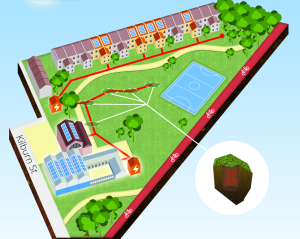Micro District Ground Source Heating
Micro district ground source heating is a system where a communal ground array provides water at ground temperature to a set of buildings to enable a heat pump in each building to extract heat for central heating and domestic hot water.
A large ground array shared across many buildings eliminates the risk of any individual buildings exhausting the capacity of its own borehole. Having a small heat pump in each buildings, with each unit paying the electric bill for its own use, ensures that each unit is responsible only for its own energy use – with no need for a complex administrative cost overhead to be shared across a set of buildings.
This approach of providing a network water circuit at ground temperature is radically cheaper than providing a hot water "load side" district heating system: it avoids the need to construct a central heat generation engine, and avoids the cost of installing a large heavily-insulated pipe network to each of the buildings, and avoids the risk of heat losses between buildings.
In addition to the elegance of this engineering solution, there are major fiscal benefits in that a micro district ground source system qualifies for the 20 year Commercial Renewable Heat Incentive ("RHI") from Government, as opposed to individual houses which only qualify for the 7 year domestic RHI. This provides major opportunities for infrastructure companies to invest in communal ground arrays for new housing developments and receive the Commercial RHI for 20 years.
It also opens the possibility of installing a micro district "source side" network to a set of existing buildings.
Micro District Heating can ...
- provide reliable low-cost green heating for spaces and hot water
- save over 75% on carbon emissions on heating compared to emissions from gas boilers
- save 100% on carbon emissions on heating and cooling when the grid is decarbonised
- provide opportunities for reducing carbon emissions by re-cycling solar energy instead of burning fossil fuels
- provide the opportunity to recover heat from buildings with high occupancy and high passive heat gains and transfer it to buildings needing heat
- attract Renewable Heat Incentive for use of ground source heat pumps
- attract Renewable Heat Incentive for use of solar thermal collectors
- earn income from Demand Side Response by shifting demand for electricity to times of slack demand
- improve urban air quality by avoiding combustion of fossil fuels or biomass in densely populated areas
Low Carbon Housing
Low carbon housing can be achieved by integrating renewable technologies including solar thermal heat capture in summer, thermal energy storage in the ground over the autumn and heat delivery by electric heat pumps using heat transfer in winter.
These technologies can be supplemented by photovoltaic electric generation and electricity storage in batteries to balance the supply and demand for electricity from the grid.
See Ground Source Heating See Ground Source Cooling See Ground Source Energy



